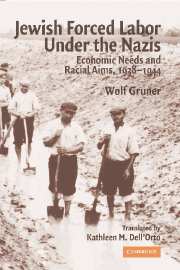Book contents
- Frontmatter
- Contents
- Abbreviations
- Introduction
- Prologue: Anti-Jewish Policies in the Nazi State before 1938
- GERMANY
- AUSTRIA
- THE PROTECTORATE OF BOHEMIA AND MORAVIA
- THE OCCUPIED TERRITORIES OF POLAND
- 6 Camps and Ghettos – Forced Labor in the Reich Gau Wartheland, 1939–1944
- 7 On the “Führer's Road” – Polish Jews in Germany, 1940–1943
- 8 The SS Organisation Schmelt and the Jews from Eastern Upper Silesia, 1940–1944
- 9 The Labor Office versus the SS – Forced Labor in the General Government, 1939–1944
- Conclusion
- Index of Subjects
- Index of Persons
- Index of Places and Camps
9 - The Labor Office versus the SS – Forced Labor in the General Government, 1939–1944
Published online by Cambridge University Press: 05 June 2012
- Frontmatter
- Contents
- Abbreviations
- Introduction
- Prologue: Anti-Jewish Policies in the Nazi State before 1938
- GERMANY
- AUSTRIA
- THE PROTECTORATE OF BOHEMIA AND MORAVIA
- THE OCCUPIED TERRITORIES OF POLAND
- 6 Camps and Ghettos – Forced Labor in the Reich Gau Wartheland, 1939–1944
- 7 On the “Führer's Road” – Polish Jews in Germany, 1940–1943
- 8 The SS Organisation Schmelt and the Jews from Eastern Upper Silesia, 1940–1944
- 9 The Labor Office versus the SS – Forced Labor in the General Government, 1939–1944
- Conclusion
- Index of Subjects
- Index of Persons
- Index of Places and Camps
Summary
EARLY INTRODUCTION OF FORCED LABOR UNDER SS CONTROL
During the campaign in September 1939, Wehrmacht units in occupied Polish territory obligated Jews to perform auxiliary tasks. In the period that followed, military and civilian offices forced men and women to clear away ruins, to fill in tank trenches, or to shovel snow. Under unsanctioned compulsory measures at Biala Polaska in October, 300 Jewish men and women had to perform cleaning tasks in public buildings and caserns for four weeks. In Zamość, between 500 and 600 people a day were recruited in raids. In Oświecim, Jews had to “report in columns to sweep the streets for purposes of education and punishment.” Abel Gimpel, at the time a young man barely twenty years old, describes how he was humiliated by a German soldier: “He said, ‘You have to wash the car….’ I said, ‘Give me a bucket and a cloth.’ He said, ‘No.’ I had on a coat that I had owned for less than two weeks. He said: ‘Take your coat and wash the car with it.’ When I was finished, he screamed: ‘Get lost.’ I wanted to take my coat with me. But he wouldn't let me have it. – I stood there in winter without a coat.” The brutal behavior of the occupiers – in occupied Poland the Einsatzgruppen began murdering at various places in the very first weeks – threw its dark shadow on future policies regarding Polish Jews.
- Type
- Chapter
- Information
- Jewish Forced Labor under the NazisEconomic Needs and Racial Aims, 1938–1944, pp. 230 - 275Publisher: Cambridge University PressPrint publication year: 2006



